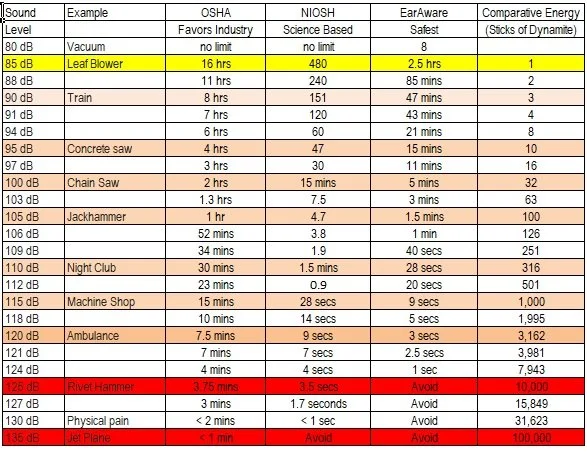OSHA vs NIOSH vs EarAware: Comparing Decibel Exposure Standards
When it comes to noise exposure, the safety standards you follow make a significant difference. Here's how OSHA, NIOSH, and EarAware guidelines compare—and why the math behind them matters for your long-term hearing health.
Understanding Exchange Rates: The Math Behind Hearing Risk
One of the key differences between these standards lies in what's called the exchange rate.
What is an exchange rate?
It’s the amount of decibel (dB) increase that cuts your safe exposure time in half.
This makes sense when you understand how sound works:
Every 3 dB increase represents a doubling of sound energy.
So, if you can safely be around 85 dB for 8 hours, then at 88 dB—twice as loud in terms of energy—you should only be exposed for 4 hours.
This halving continues with each 3 dB increase.
The lower the exchange rate, the more protective the standard is. Here’s how that plays out:
OSHA: Designed for Industrial Workers
Purpose: OSHA (Occupational Safety and Health Administration) regulations are designed to protect workers in industrial and manufacturing settings, not people at concerts, gyms, or restaurants.
Thresholds:
Hearing protection is required when exposure exceeds 85 dBA over 8 hours.
Workers can legally be exposed to 90 dBA for 8 hours before mandatory mitigation.
Exchange Rate: 5 dB
That means a person could be exposed to 95 dBA for 4 hours, 100 dBA for 2 hours, and so on.
Problems with This Approach:
A 5 dB exchange rate doesn’t reflect the true doubling of sound energy, making it less protective.
Does not account for hearing damage accumulated outside the workplace.
Under OSHA’s limits, about 25% of workers exposed to 90 dBA over a career will suffer permanent hearing loss.
NIOSH: A Safer, Science-Based Standard
Purpose: NIOSH (National Institute for Occupational Safety and Health) sets recommended limits based on the physics of sound and the biology of hearing loss.
Thresholds:
Maximum recommended exposure is 85 dBA for 8 hours.
Exchange Rate: 3 dB
This better reflects the reality that each 3 dB increase doubles sound energy. Safe exposure times under NIOSH:
88 dBA → 4 hours
91 dBA → 2 hours
94 dBA → 1 hour
97 dBA → 30 minutes
100 dBA → 15 minutes
Risk: Even with this more protective model, a full career at 85 dBA still carries a 12% chance of hearing loss.
EarAware: Protection for Every Environment
Purpose: EarAware standards were created to go beyond industrial safety and address real-world, non-occupational sound exposure in places like:
Music venues
Gyms and fitness classes
Restaurants and bars
Theaters, festivals, and more
Exchange Rate: 3 dB or lower
EarAware uses the same scientifically accurate 3 dB model as NIOSH—but recommends even shorter exposure durations and lower peak levels, especially when:
Exposure is repeated day after day
Hearing is already compromised
People are seeking to prevent even mild damage
Audience: These guidelines are ideal for anyone serious about preserving their hearing, such as musicians, sound engineers, health-conscious consumers, and parents protecting their kids from early damage.
Are You Providing Ear Protection?
If your venue regularly exceeds 85 dBA, are you offering earplugs to staff and guests?
If not, you're falling short—even by OSHA standards— Please go for proactive hearing protection!
Sound Safety Is a Choice
Hearing damage is invisible, irreversible, and cumulative.
Following the bare minimum legal standard is not the same as being safe. Choose to go beyond compliance. Choose to protect your guests, your team—and yourself.
Join the EarAware movement.
Offer hearing protection
Post real-time decibel levels
Limit peak sound exposure
Get EarAware Certified

